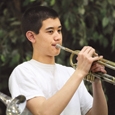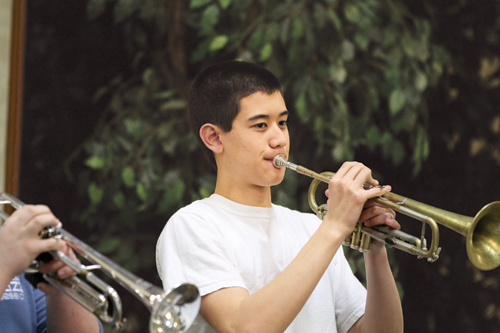
When college and university trumpet teachers were asked to identify the main playing problems of freshman, the answers all led back to fundamental aspects of brass playing. High school trumpet players who are considering a major in music would do well to focus on these basic skills.
Build a Library
Students should start building a library of books and solos while still in high school. The studio teacher will help decide which solos each trumpet major should study, but consulting state lists for suitable solo literature is an excellent way to start. Method books such as Arban’s Complete Conservatory Method, Clarke’s Technical Studies, Schlossberg’s Daily Drills and Technical Studies, and the Concone Lyrical Studies for Trumpet are almost universally required. The ideas presented below will point the students in the right direction, but these great method books offer lengthy and advanced studies for players of all levels.
Warm Up Correctly
Few students know how to warm up effectively. A good method is to start with the students standing or sitting with good posture and taking in a deep breath while saying the syllable oh. This inhalation should be done in eight beats. They should then release the air over eight beats saying the syllable poo. This should be done four times at a tempo of q = 80. By adding this exercise to each practice session, students will be more likely to incorporate relaxed breathing into their playing. This helps to establish steady air flow, breath support, and good tone quality.
Next, students should play the exercises below on the mouthpiece at the same tempo, slurred, and using a poo syllable at the beginning. Students struggling with the pitch can play the first note on the trumpet for reference. It is important to keep the tone steady and full, breathing in and out as noted above, and resting four beats between each segment. They should repeat this on the trumpet using the poo syllable at first, then gradually add the tongue and use a too syllable. Arnold Jacobs taught that it is better to think of this syllable as tOO in order to emphasize the vowel and, hence, the tone. This exercise can continue up and down the scale and can be transposed to other keys.
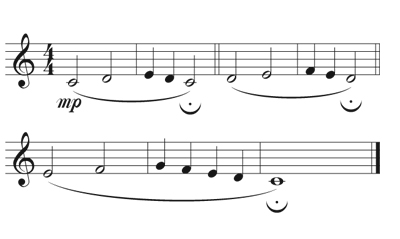
Master Scales and Arpeggios
There is no such thing as too much proficiency in scales. Students should be familiar with the all-state band audition requirements for their state and use them as a guide. These auditions include scales and arpeggios and give instructions on how to play them. Students should practice the scales in the way prescribed and not avoid difficult keys. A great goal is to be able to play two octave scales and arpeggios in eighth notes up to C6 at a steady tempo, q = 120. It will enhance technique and flexibility if students can play major and chromatic scales both tongued and slurred and in a variety of articulations.
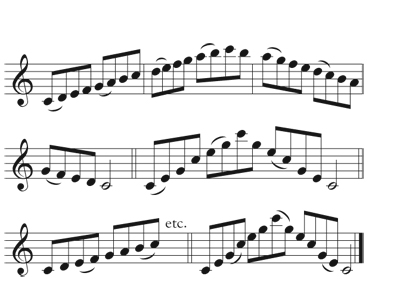
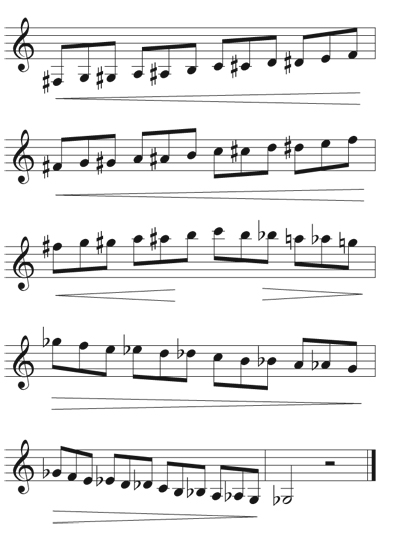
Learn Multiple Tonguing Styles
Young players often use extremely harsh articulations. They should practice simple drills and melodies using the poo syllable, which does not employ the tongue, and move gradually to a dAH or dOO syllable to start the note. Using softer syllables in legato playing is crucial to learning correct style. In this style, students should avoid a hard Tee articulation, and avoid stopping the sound with the tongue (TuT).
Beginning college students start with an advantage if they can double and triple tongue well; these articulations are necessary for performing at fast tempos. Teachers should introduce double tonguing by the time students enter the 8th or 9th grade and triple tonguing by the 11th or 12th. Students should start with single pitch drills, played slowly. They can gradually move to other pitches and increase the tempo to at least q = 120. Once students master this, it is a matter of achieving consistency, speed, and endurance through repetition. It is advisable to practice multiple tonguing up and down the scales and not linger on the single pitch exercise once it is mastered. Students should work on multiple tonguing every day.
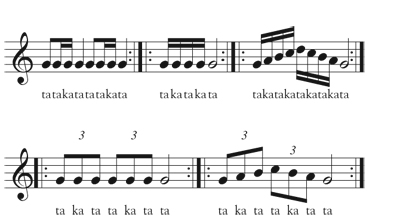
Build Flexibility
The ability to move up and down scales in single, double, triple, and mixed tonguing and slurring patterns is an important part of developing agility and flexibility, but lip slurs are an important part of this as well. The lip slur exercises in methods such as the Arban and Schlossberg should be a part of every trumpeter’s daily routine. The example below shows the open notes that should be slurred; the student should continue lower, through all seven valve combinations. Fast lip slurs help with range, but it is best to learn them slowly at first at about q = 80.
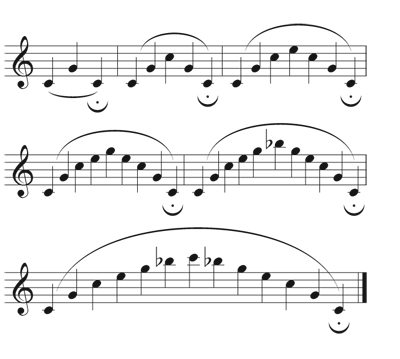
Sightread Daily
An effective approach is to explore the Fourteen Characteristic Studies in the Arban method. Sightreading a line or phrase from these every day is extremely beneficial. Playing duets with other players and reading trumpet parts from pieces in the band library are also good approaches. Players should not just practice the notes, but also learn the meaning of the musical terms and tempo markings on the page.
Play with Others
Much can be learned about faulty pitch and rhythmic problems by playing solos with pianists, organists, and other instrumentalists. Playing with other instruments, especially piano, is also a great way to learn how to listen critically. Unless the student has prepared for solo and ensemble contests before, this could be an overlooked area. Performing solos and in small ensembles will also teach students to count rests independently and not depend on help from the section as in larger ensembles.
Use Technology
There are also software programs that will help to develop rhythmic accuracy. Even if the software is unavailable, just using a metronome that subdivides the beat will make many problems obvious. It is a good idea to use a tuner to learn pitch tendencies, but don’t depend on it as a crutch. Recording practice sessions and listening to one’s playing are the best ways to correct these problems. Singing parts also develops the ear and can be done without the instrument or tiring the chops.
Play with Expression and Character
Music should tell a story. Kevin Eisenmith of Indiana University of Pennsylvania assigns his students a simple melody such as a Concone study or one of the songs from the Arban method. He requires students to add dynamics, crescendos, and tempos, to make it interesting and expressive. Students might imagine the scene or idea they are trying to convey and exaggerate dynamics and tempo changes. Such creativity will bring images to life for the listener.
Listen to Great Players
Students should use the various media to learn the work of great artists. Jon Burgess of Texas Christian University sees a need for young students to check out the trumpet greats: Maurice Andrè, Phil Smith, Adolph Herseth, Tom Hooten, Alison Balsom, Chris Martin, Louis Armstrong, Miles Davis, and Wynton Marsalis. Knowing about these players and their styles is a part of being musically literate.
Mastery of fundamentals leads to artistry and success. It is the player with superb command of basic skills who wins the audition, not just the one who can play higher, faster, and louder. As students head to college, they might find themselves in a bigger pond of extremely talented people. The student who spends 5-10 minutes each day on fundamentals can discover weaknesses, fix them, and rise above the rest.
